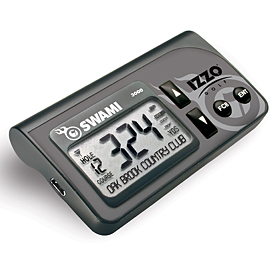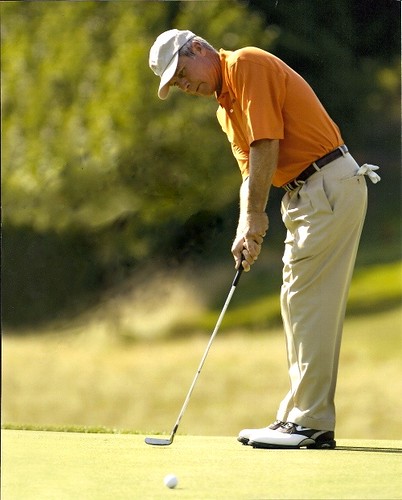I use the Bushnell 1500 Pinseeker with slope.

Since I live in Florida, the slope edition almost never comes into play. Obviously, I cannot use it for tournaments, but I always wanted to be able to point out the distances to a hole with a lot of slope on it in the practice round if necessary.
In my opinion, all of the GPS and Rangefinders…even those with slope, should be legalized for this purpose. Let’s make the game faster and if we can, make it appear more friendly to golfers. Personally, if I’m playing a round of golf and don’t have something to tell me the yardage, I have no issue with pacing the yardage off, looking at the pin sheet and take more time to get the yardage.
My feeling on the subject is that golfers still have to hit the shot at hand. I could be told the exact and correct yardage every single time and Luke Donald could have to guess the yardages every single time, but Luke Donald is going to hit far better shots than I will. And the professionals are able to have their caddies design intricate yardage books that will pretty much get them the exact yardage and tell them how putts break, etc.
If anything, the banning of rangefinders and GPS units in some tournaments is really hypocritical and thus can come down to what player has the time and money to get a caddy to come up with an intricate yardage book and which one doesn’t. Again, I don’t think it’s that much of an advantage in the end, but PGA and USGA events are helping create more of an advantage than they are keeping players on a level playing field.
Anyway, recently I was given the Swami 3000 by Izzo Golf to try out.

While I’m not an expert at the history of GPS units, my knowledge of them is that they first started costing about $400+ and that did not include the annual membership and course downloading fees. Eventually, people started to see this as pretty expensive for getting accurate yardage and with the struggling economy, the interest in these high priced units annual and course download fees declined.
Now, we are starting to see GPS units modeled much like the Swami 3000. This is a unit that only tells the yardage to the front, center and back part of the green with 19,000 courses pre-loaded and no annual or downloading fees.
ACCURACY
Fortunately, my father has a Bushnell Neo device, so I could use the Swami 3000 along with my Bushnell 1500 Pinseeker to help gauge the accuracy. I feel that accuracy is the most important part for me.
For the most part, the Swami 3000 and the Bushnell Neo were getting pretty much the same reading. Since I cannot take my rangefinder and measure the actual yardage to the front or the back of the green, I had to shoot at the flagstick and then guesstimate the exact yardage to the front or back of the green. Again, the Swami 3000 measured up quite well.
As far as accuracy goes, the only problem is really the limits in the design. You’re not going to get yardages to the water or a fairway bunker or a mound with this type of design. Also, it measures the yardage directly, in a straight line to the hole. If you are on a sharp dog leg where the course has measured the hole from the tee box to the middle of the fairway to the middle of the green, the Swami will come up with a very different reading. For instance, we played one hole that was a pretty sharp dogleg right where you could not hit the tee shot over the dogleg. The scorecard yardage was more of an accurate depiction of the hole at 400 yards, but the Swami, which uses a straight line to the hole said it was 340 yards. Obviously, the same applies for the Bushnell Neo.
EASE OF USE
I wound up putting it to the ultimate test in my mind by first using the Swami in The Villages, FL. For those who don’t know much about The Villages, it’s essentially a retirement *city* that is filled with golf courses. You cannot go more than 300 yards it seems without running into a golf hole. The small city holds at it’s peak, 82,000 old farts : ) and has 30 different par-3 courses and 10 different championship courses. Most of the par-3 courses are at least 18 holes and most of the championship courses are 27 holes.
It’s a good test of if the GPS unit can locate the correct course that you are on. My dad and I were playing Tierra Del Sol Golf Club which has 3 different par-3 courses right next to it.
At first, I struggled how to get the GPS onto Tierra Del Sol as I left my directions for it at home. But, I eventually figured it out. Overall, I would say the Bushnell Neo was a little easier to get the course, but part of it was due to me not having the instructions on hand. Furthermore, I doubt anybody outside of The Villages would have a situation like this where all of these golf courses are right next to each other. I’ve played in Pinehurst and lived in Myrtle Beach for years and those places are nothing like The Villages when it comes to golf holes everywhere you look.
The Swami does have a nice clip so you clip it to your side pocket or on your golf cart.

When you get the GPS, you have to charge it. I charged mine overnight, but I think it was ready to be used after a few hours. I remember when my dad had to charge his Bushnell Neo, it took a much longer time to charge..
My main complaints against the Swami are:
1) You have to manually change it to the hole you are on.
This is not difficult to do. You just click the arrow to the hole you are on and it will give you the distance. However, this does not have to be done with the Bushnell Neo as it automatically puts you on the hole you are on.
2) You have to manually change it to the part of the green you want the yardage to.
Again, not difficult to do. But, the Bushnell Neo tells you what the yardage to the front, center and back of the green every time. With the Swami 3000, you have to manually click the ‘FCB’ button to get the front, center and back green yardages. That being said, if you have poor eyesight, you are more apt to have a harder time reading the Bushnell Neo front and back yardages than the Swami 3000 yardages.
While those 2 things might be nitpicky, if you’re not careful you might wind up with the yardage to the wrong hole or to the wrong part of the green.
OVERALL
I think the Swami 3000 is a good GPS unit as long as you are aware that it only tells front, back and center green locations and that you will have to manually move the GPS to the hole you are on. I think those obstacles are very simple to overcome and would not be a problem 99% of the time. It has more pre-loaded courses than the Bushnell Neo or Bushnell Neo+ (19,000 vs. 16,000).
The cost for a new unit is about $85. That is the same price for the Bushnell Neo, although it appears that the Neo will not be made much longer as Bushnell starts rolling out the Neo plus, which is a similar device, but supposedly has yardages to key hazards as well.
I feel you probably won’t notice much of a difference between the Bushnell Neo or the Izzo Swami 3000. If you’re at a store and all you see is the Neo, I would ask what the warranty is since Bushnell is replacing it with the Neo plus. But, if you only see the Swami 3000, you should feel confident in your purchase. I know I will be using it at the FSGA Mid-Am because it's legal to use the device at that tournament.
3JACK























